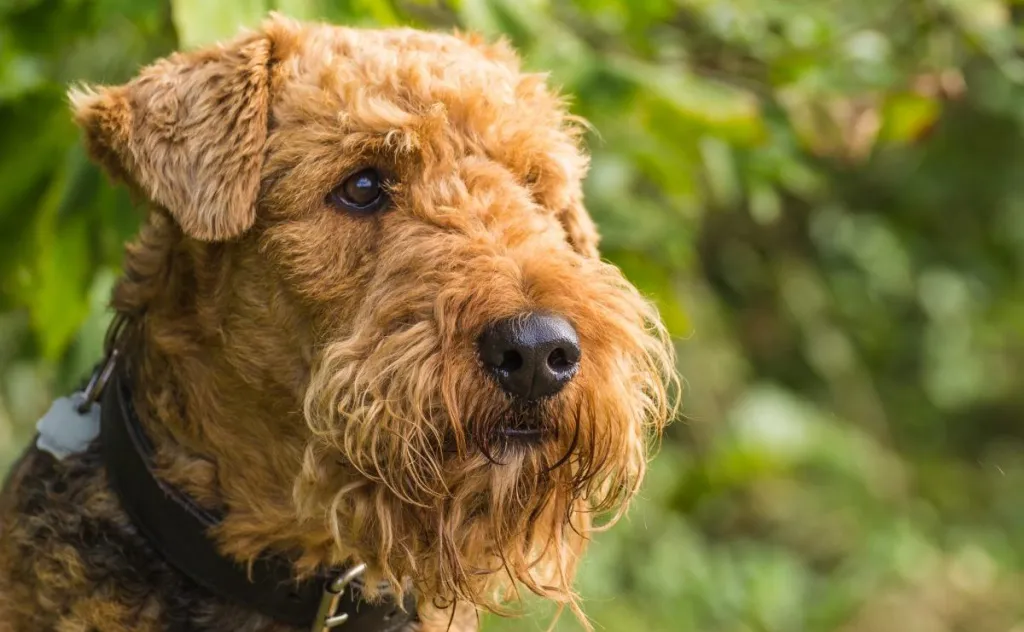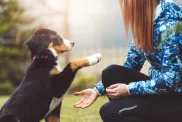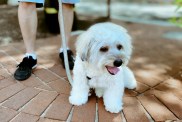Renowned as the “King of Terriers,” the Airedale holds the distinction of being the largest among all terrier breeds. Originating in the Aire Valley of Yorkshire, their primary task was to hunt otters and rats in the region between the Aire and Wharfe Rivers. Over time, Airedales proved their skill in sporting. Their versatility made them invaluable working dogs, notably during World War I.
Males of the Airedale breed typically stand at around 23 inches at the shoulder, while females are slightly shorter. Their dense, wiry coat showcases a tan color with distinctive black markings. With long, muscular legs, Airedales exude a regal and dignified appearance. Their head is long, adorned with a sporty beard and mustache, complemented by dark eyes and neatly folded ears, all of which convey a keen intelligence. Airedales possess the classic alert and willing demeanor of terriers, only in a larger size. Similar to their smaller terrier counterparts, they can be bold, determined, and occasionally stubborn.
The Airedale Terrier boasts intelligence, an outgoing nature, and unwavering confidence. Their playful disposition brings joy to their human companions. However, potential pet parents should be aware of their high energy levels and need for plenty of exercise. Novices and apartment dwellers may find the Airedale’s intensity a bit challenging to handle, especially for first-time dog trainers. Nonetheless, if you can meet their physical requirements and provide ample space for play, you’ll be rewarded with a loving and playful companion that the entire family, including children, will adore.
Quick Facts
- Origin: Aire Valley, Yorkshire, England
- Size: 22-24 inches tall at the shoulder, 45-65 pounds
- Lifespan: 10-13 years
- Coat: Wiry, harsh, and double layer that comes in black, tan, or brindle
- Temperament: Intelligent, loyal, playful, and fearless
- Exercise needs: High
- Training: Needs to be trained with firmness and consistency
- Grooming: Needs to be brushed 2-3 times a week and hand-stripped once a month
- Health: Generally healthy, but can be prone to some health problems, such as hip dysplasia and elbow dysplasia
- During World War II, Airedales served as messenger dogs and in search and rescue. They earned the distinction of being regarded as war heroes.
- The Airedale won the favor of many celebrities, including Woodrow Wilson, Olivia De Havilland, James Earl Jones, Theodore Roosevelt, and John Wayne, to name a few.
- An Airedale Terrier named Kipper plays a supporting role in Disney’s live-action adaptation of “101 Dalmations.”
While Airedales are purebred dogs, you may still find them in the care of rescue groups or shelters. If you’re considering bringing one of these delightful pups into your home, opting to adopt is a commendable choice!
Airedale Terrier Dog Pictures
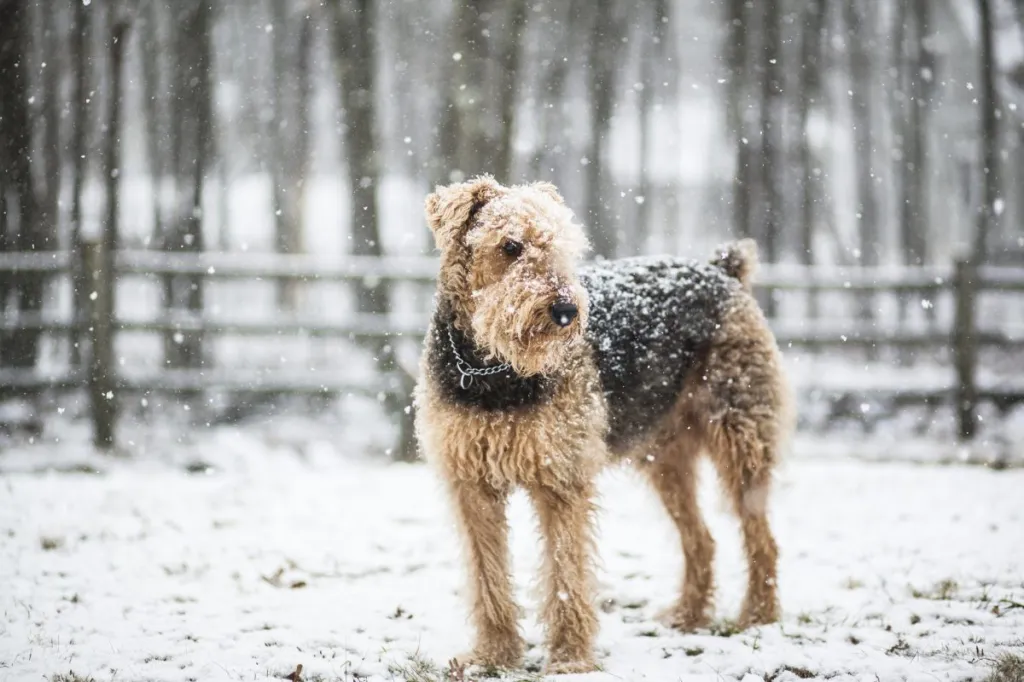
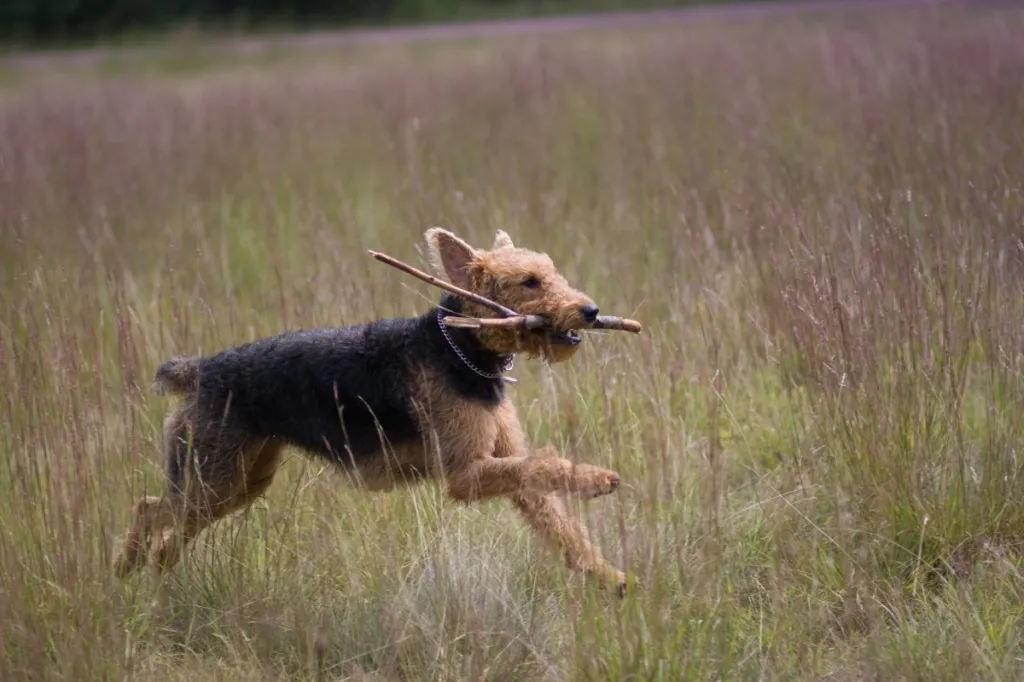
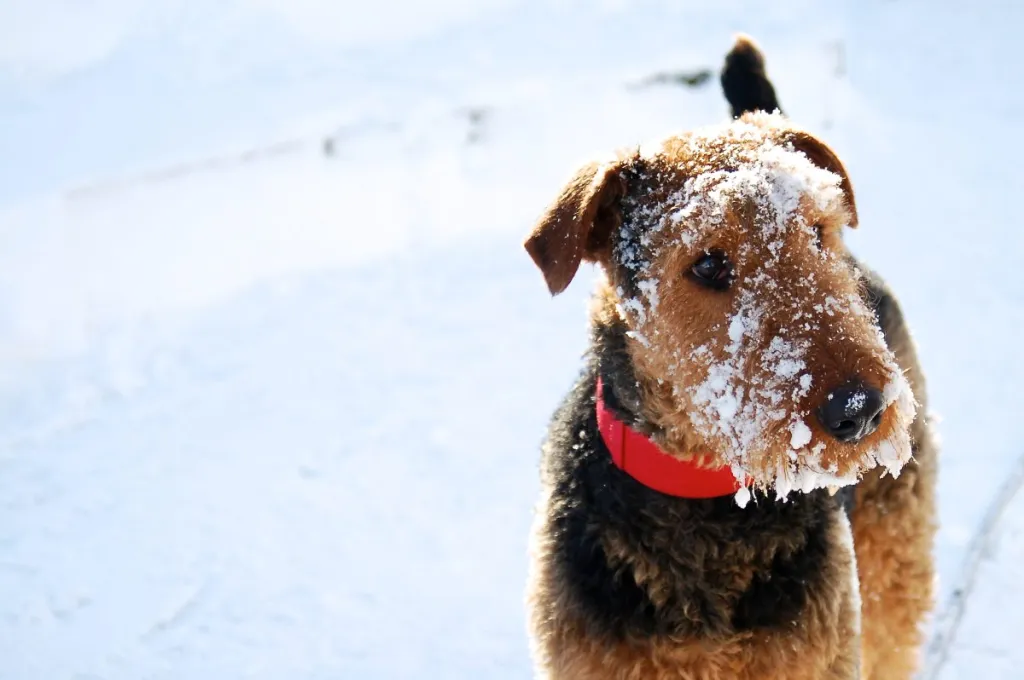
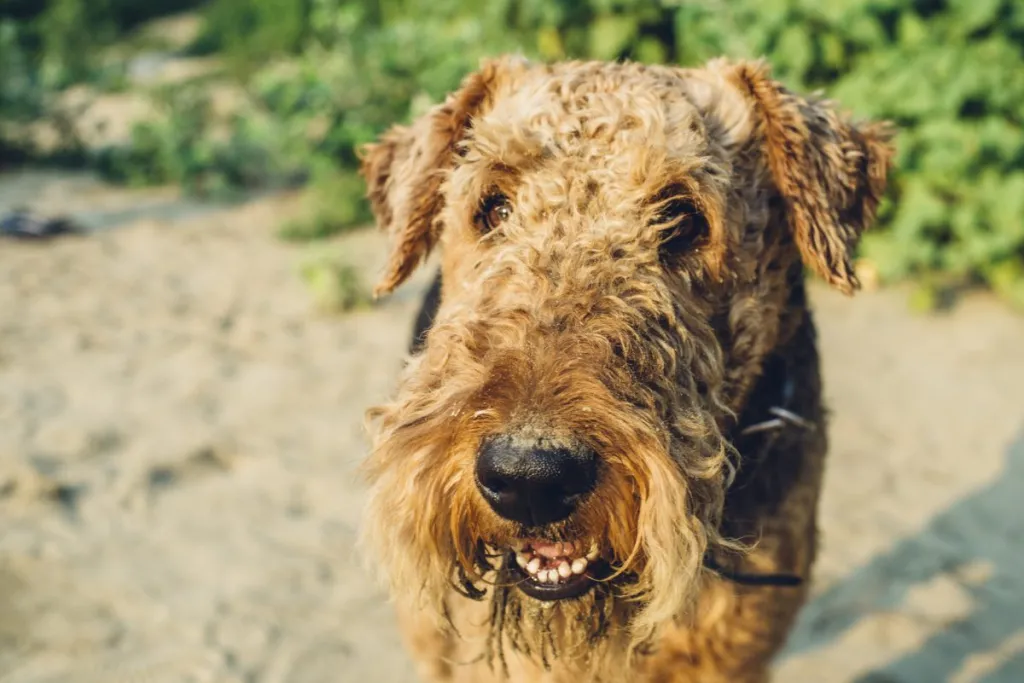
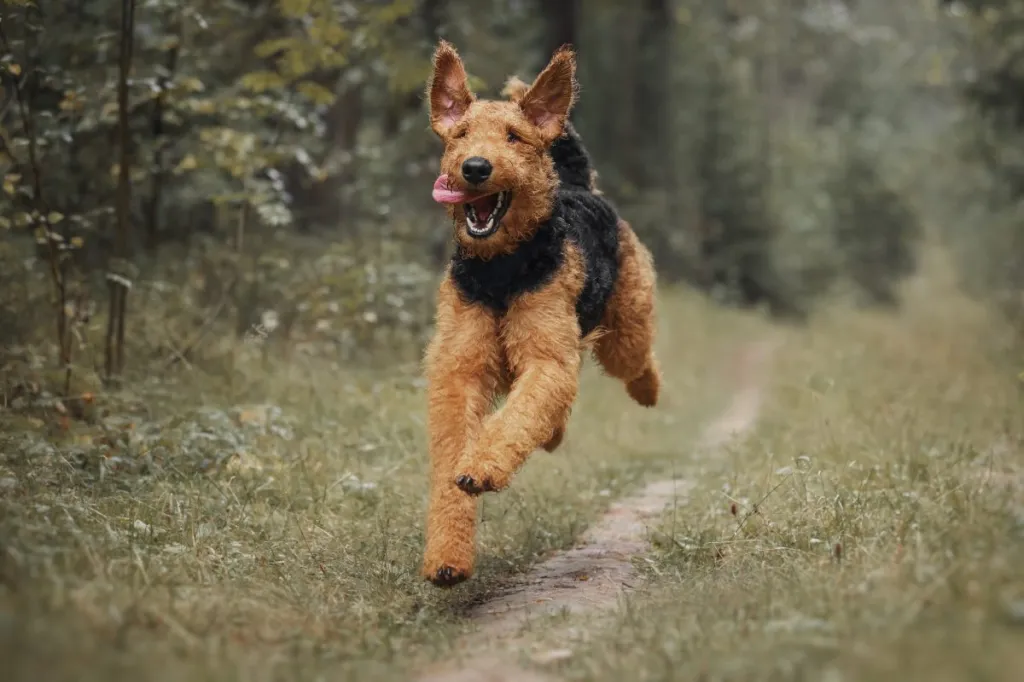
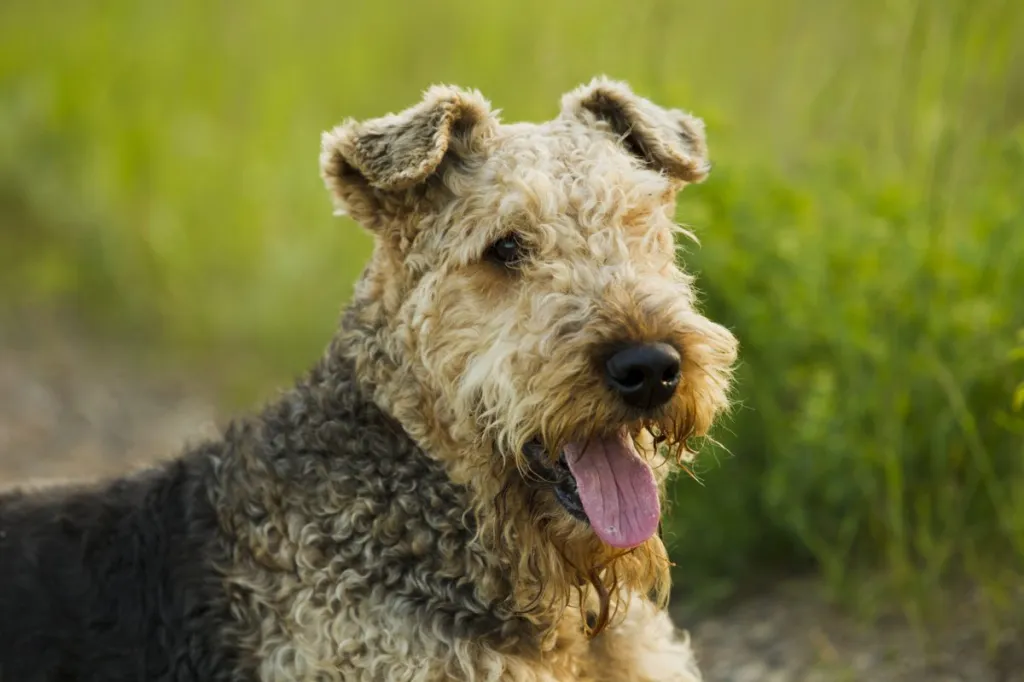
Adaptability
-
Adapts Well To Apartment Living
Looking for the best dog for your apartment? Contrary to popular belief, the suitability of dogs who adapt well to apartment living goes beyond its size. Apartment dwellers have a myriad of dog breeds to choose from as potential companions, with various factors to consider. Some large breeds can adapt well to apartment living and have lower activity levels. Others may require more space and possess higher energy levels. On the other hand, certain small dog breeds with abundant energy can still find contentment with indoor playtime or brisk walks.
However, when selecting a dog that adapts well apartments, it is essential to prioritize your neighbors. Opting for a pet that doesn’t excessively bark and behaves politely when encountering others in shared spaces like is crucial for maintaining a harmonious apartment environment.
In high-rise settings, it’s worth noting that numerous small dogs may exhibit a propensity for high energy and frequent barking. This makes them less suitable for apartment living. Therefore, desirable qualities in an apartment dog encompass being quiet, low-energy, and displaying polite behavior towards other residents.
Factors To Consider When Choosing A Dog For An Apartment
When considering dogs that adapt well to apartments, size alone should not be the sole determinant. Apartment dwellers have a wealth of dog breeds to choose from as potential furry companions. It’s important to remember that the size of your living space is just one factor to consider. While some larger breeds can adapt well to apartment living, with lower, others may require more space and have higher energy levels, making them less suitable for smaller apartments. Conversely, certain small dog breeds with higher energy levels can still thrive in apartments, finding contentment through indoor playtime or brisk walks. However, it is crucial to consider your neighbors’ comfort when selecting a dog. Opt for a pet that doesn’t bark excessively and behaves politely when interacting with others in shared spaces.
Therefore, it’s important to prioritize qualities such as being quiet, low-energy, calm indoors, and exhibiting good manners when living in close proximity to other residents. By considering these factors, you can find a dog that will adapt well to apartment living and create a harmonious living environment for everyone involved.
-
Good For Novice Owners
Some dogs are simply easier than others; they take to training better and are fairly easygoing. They’re also resilient enough to bounce back from your mistakes or inconsistencies.
Dogs who are highly sensitive, independent thinking, or assertive may be harder for a first-time dog parent to manage. You’ll get your best match if you take your dog-owning experience into account as you choose your new pooch.
If you’re new to dog parenting, take a look at 101 Dog Tricks and read up on how to train your dog!
-
Sensitivity Level
Some dogs will let a stern reprimand roll off their backs, while others take even a dirty look to heart. Low-sensitivity dogs, also called “easygoing,” “tolerant,” “resilient,” and even “thick-skinned,” can better handle a noisy, chaotic household, a louder or more assertive owner, and an inconsistent or variable routine. Do you have young kids, throw lots of dinner parties, play in a garage band, or lead a hectic life? Go with a low-sensitivity dog.
-
Tolerates Being Alone
Some breeds bond very closely with their family and are more prone to worry or even panic when left alone by their owner. An anxious dog can be very destructive–barking, whining, chewing, and otherwise causing mayhem. These breeds do best when a family member is home during the day or if you can take the dog to work.
-
Tolerates Cold Weather
Breeds with very short coats and little or no undercoat or body fat, such as Greyhounds, are vulnerable to the cold. Dogs with a low cold tolerance need to live inside in cool climates and should have a jacket or sweater for chilly walks. You can find a great jacket for your dog here!
-
Tolerates Hot Weather
Dogs with thick, double coats are more vulnerable to overheating. So are breeds with short noses, like Bulldogs or Pugs, since they can’t pant as well to cool themselves off. If you want a heat-sensitive breed, your dog will need to stay indoors with you on warm or humid days, and you’ll need to be extra cautious about exercising your dog in the heat.
All-around friendliness
-
Affectionate With Family
When it comes to unconditional love and unwavering loyalty, few animals can rival the affectionate nature of dogs. These remarkable creatures have earned their reputation as man’s best friend, and many breeds are particularly renowned for their love and devotion to their families. With their warm hearts and wagging tails, affectionate family dogs enrich the lives of their owners in countless ways.
One such breed known for its affectionate demeanor is the Golden Retriever. With their gentle temperament and friendly disposition, Golden Retrievers form deep bonds with their families. They eagerly participate in family activities, whether it’s a game of fetch in the yard or cuddling on the couch during a movie night. Their expressive eyes and ever-wagging tails are a testament to the joy they feel in the presence of their loved ones.
Another family-favorite breed is the Labrador Retriever. Renowned for their playful and patient nature, Labradors are excellent companions for children and adults alike. They readily engage in playtime with the kids, showcasing their boundless energy and enthusiasm. But when the day winds down, they seamlessly transition into loving and gentle cuddle buddies, comforting their family members with their warm presence.
Beyond specific breeds, mixed-breed dogs also have a special place in the hearts of families seeking affectionate companions. The shelter dogs, in particular, form deep connections with their adoptive families. They seem to understand the second chance they’ve been given and repay it with endless love and gratitude.
How To Know If A Dog Is Good With Families
The affectionate nature of family dogs extends beyond play and cuddles. Dogs have a remarkable ability to sense their owner’s emotions, offering comfort and support during difficult times. Whether it’s a wagging tail after a long day at work or a sympathetic nuzzle during moments of sadness, they prove time and again that they are attuned to their family’s needs.
It is important to note that not all dogs of the same breed will be equally affectionate. Some dogs may be more independent or aloof, while others may be more clingy or demanding of attention. The best way to find out how affectionate a dog is is to meet them in person and interact with them.
-
Kid-Friendly
Being gentle with children, sturdy enough to handle the heavy-handed pets and hugs they can dish out, and having a blasé attitude toward running, screaming children are all traits that make a kid-friendly dog. You may be surprised by who’s on that list: Fierce-looking Boxers are considered good with children, as are American Staffordshire Terriers (which are considered Pit Bulls). Small, delicate, and potentially snappy dogs such as Chihuahuas aren’t always so family-friendly.
**All dogs are individuals. Our ratings are generalizations, and they’re not a guarantee of how any breed or individual dog will behave. Dogs from any breed can be good with children based on their past experiences, training on how to get along with kids, and personality. No matter what the breed or breed type, all dogs have strong jaws, sharp pointy teeth, and may bite in stressful circumstances. Young children and dogs of any breed should always be supervised by an adult and never left alone together, period.
-
Dog Friendly
Friendliness toward dogs and friendliness toward humans are two completely different things. Some dogs may attack or try to dominate other dogs, even if they’re love-bugs with people; others would rather play than fight; and some will turn tail and run. Breed isn’t the only factor. Dogs who lived with their littermates and mother until at least six to eight weeks of age and who spent lots of time playing with other dogs during puppyhood, are more likely to have good canine social skills.
-
Friendly Toward Strangers
Stranger-friendly dogs will greet guests with wagging tails and nuzzles; others are shy, indifferent, or even aggressive. However, no matter what the breed, a dog who was socialized and exposed to lots of different types, ages, sizes, and shapes of people as a puppy will respond better to strangers as an adult. Remember that even friendly dogs should stay on a good, strong leash like this one in public!
Health And Grooming Needs
-
Amount Of Shedding
If you’re going to share your home with a dog, you’ll need to deal with some level of dog hair on your clothes and in your house. However, shedding does vary greatly among the breeds. Some dogs shed year-round, some “blow” seasonally, some do both, and some shed hardly at all. If you’re a neatnik, you’ll need to either pick a low-shedding breed or relax your standards. To help keep your home a little cleaner, you can find a great de-shedding tool here!
-
Drooling Potential
Drool-prone dogs may drape ropes of slobber on your arm and leave big, wet spots on your clothes when they come over to say hello. If you’ve got a laid-back attitude toward slobber, fine; but if you’re a neatnik, you may want to choose a dog who rates low in the drool department.
-
Easy To Groom
Some breeds are brush-and-go dogs; others require regular bathing, clipping, and other grooming just to stay clean and healthy. Consider whether you have the time and patience for a dog who needs a lot of grooming, or the money to pay someone else to do it.
-
General Health
Due to poor breeding practices, some breeds are prone to certain genetic health problems, such as hip dysplasia. This doesn’t mean that every dog of that breed will develop those diseases; it just means that they’re at an increased risk.
If you’re adopting a puppy, it’s a good idea to find out which genetic illnesses are common to the breed you’re interested in. You may also want to ask if your shelter or rescue has information about the physical health of your potential pup’s parents and other relatives.
-
Potential For Weight Gain
Some breeds have hearty appetites and tend to put on weight easily. As in humans, being overweight can cause health problems in dogs. If you pick a breed that’s prone to packing on pounds, you’ll need to limit treats, make sure they get enough exercise, and measure out their daily food servings into regular meals rather than leaving food out all the time.
Ask your vet about your dog’s diet and what they recommend for feeding your pooch to keep them at a healthy weight. Weight gain can lead to other health issues or worsen problems like arthritis.
-
Size
Get ready to meet the giants of the doggy world! Large dog breeds aren’t just big balls of fluff, they’re like loving, oversized teddy bears on a mission to steal your heart. Need some convincing? Let’s dive into the awesome benefits of owning one!
First things first, these pooches are a living security system! With their impressive size and thunderous barks, they’ll have any would-be intruder running for the hills. Talk about peace of mind! Plus, who needs an alarm when you’ve got a furry giant protecting your castle?
But that’s not all. Large dog breeds are all about loyalty and devotion. They’ll stick by your side through thick and thin, becoming your most dedicated bestie. Their love knows no bounds! When you have a giant fluffball showing you unconditional love, you’ll feel like the luckiest human on the planet.
Now, let’s talk about their talents. These big fellas are the ultimate working partners. With brains and brawn, they’re up for any challenge. From search and rescue missions to lending a helping paw to those in need, these dogs are superheroes in fur coats. They’ll make you proud every step of the way!
Don’t let their size fool you—these gentle giants have hearts as big as their paws. They’re incredible with kids and other pets, spreading their love like confetti. Their patience and kindness make them perfect family pets, ensuring harmony in your household.
Oh, and get ready to break a sweat! These dogs are fitness enthusiasts, and they’ll keep you on your toes. Daily walks, jogs, and play sessions will not only keep them happy and healthy but will also give you a reason to ditch the couch and join in on the fun. It’s a win-win situation!
So, if you’re ready for a dose of big love, go ahead and consider a large dog breed. They’re the best wing-dog you could ever ask for, ready to make your life a thousand times more exciting, loving, and downright awesome! Get ready for the big adventure of a lifetime!
Trainability
-
Easy To Train
Easy-to-train dogs are more adept at forming an association between a prompt (such as the word “sit”), an action (sitting), and a consequence (getting a treat) very quickly. Other dogs need more time, patience, and repetition during training.
Many breeds are intelligent but approach training with a “What’s in it for me?” attitude, in which case you’ll need to use rewards and games to teach them to want to comply with your requests.
Related:
10 Fun, Impressive Tricks You Can Teach Any Dog
-
Intelligence
Dogs who were bred for jobs that require decision making, intelligence, and concentration, such as herding livestock, need to exercise their brains, just as dogs who were bred to run all day need to exercise their bodies. If they don’t get the mental stimulation they need, they’ll make their own work–usually with projects you won’t like, such as digging and chewing. Obedience training and interactive dog toys are good ways to give a dog a brain workout, as are dog sports and careers, such as agility and search and rescue.
-
Potential For Mouthiness
Common in most breeds during puppyhood and in Retriever breeds at all ages, mouthiness means a tendency to nip, chew, and play-bite (a soft, fairly painless bite that doesn’t puncture the skin). Mouthy dogs are more likely to use their mouths to hold or “herd” their human family members, and they need training to learn that it’s fine to gnaw on chew toys, but not on people. Mouthy breeds tend to really enjoy a game of fetch, as well as a good chew on a toy that’s been stuffed with kibble and treats.
-
Prey Drive
Dogs with a high prey drive have an instinctive desire to stalk, capture, and prey upon potential food sources. Dogs who were bred to hunt, such as Terriers, have an inborn desire to chase — and sometimes kill — other animals. Anything whizzing by — such as cats, squirrels, and perhaps even cars — can trigger that instinct.
How to address a high prey drive
Off-leash adventures are too great a temptation for pups who will wander and hunt. Dogs who like to chase need to be leashed. And, even on a leash, you may experience your dog pulling on the leash to reach rodents or birds in their sight. Otherwise, these pups should be kept in a fenced area when outdoors. If your pup has a high prey drive, you’ll need a high, secure fence in your yard.
These breeds generally aren’t a good fit for homes with smaller pets that can look like prey, such as cats, hamsters, or small dogs. Breeds that were originally used for bird hunting, on the other hand, generally won’t chase, but you’ll probably have a hard time getting their attention when there are birds flying by.
Other behavioral concerns
Observing your dog’s prey drive, which is instinctual and biologically-rooted, is not the same as observing aggression. Much aggression is born of fear and anxiety, especially in the case of dog aggression toward humans.
The tendency to wander, even into oncoming traffic, can produce diasterious results for pups with predatory instincts. It can also lead to pups being bitten by snakes or attacked by other wild animals they may pursue while on the hunt.
-
Tendency To Bark Or Howl
Some breeds sound off more often than others. When choosing a breed, think about how often the dog vocalizes. Learn more about breeds with a tendency to bark or howl.
If you’re considering a hound, would you find their trademark howls musical or maddening? If you’re considering a watchdog, will a city full of suspicious “strangers” put your pup on permanent alert? Will the local wildlife literally drive your dog wild? Do you live in housing with noise restrictions? Do you have neighbors nearby? Then you may wish to choose a quieter dog.
-
Wanderlust Potential
Some breeds are more free-spirited than others. Nordic dogs such as Siberian Huskies were bred to range long distances, and given the chance, they’ll take off after anything that catches their interest. And many hounds simply must follow their noses–or that bunny that just ran across the path–even if it means leaving you behind.
Exercise needs
-
Energy Level
High-energy dogs are always ready and waiting for action. Originally bred to perform a canine job of some sort, such as retrieving game for hunters or herding livestock, they have the stamina to put in a full workday. They need a significant amount of exercise and mental stimulation, and they’re more likely to spend time jumping, playing, and investigating any new sights and smells.
Low-energy dogs are the canine equivalent of a couch potato, content to doze the day away. When picking a breed, consider your own activity level and lifestyle, and think about whether you’ll find a frisky, energetic dog invigorating or annoying.
-
Intensity
A vigorous dog may or may not have high energy, but everything they do, they do with vigor: they strain on the leash (until you train them not to), try to plow through obstacles, and even eats and drinks with great big gulps. These dynamos need lots of training to learn good manners, and may not be the best fit for a home with young kids or someone who’s elderly or frail. A low-vigor dog, on the other hand, has a more subdued approach to life.
-
Exercise Needs
Some breeds do fine with a slow evening stroll around the block. Others need daily, vigorous exercise, especially those that were originally bred for physically demanding jobs, like herding or hunting.
Without enough exercise, these breeds may put on weight and vent their pent-up energy in ways you don’t like, such as barking, chewing, and digging. Breeds that need a lot of exercise are good for outdoorsy, active people, or those interested in training their dog to compete in a high-energy dog sport, such as agility.
-
Potential For Playfulness
Some dogs are perpetual puppies — always begging for a game — while others are more serious and sedate. Although a playful pup sounds endearing, consider how many games of fetch or tag you want to play each day, and whether you have kids or other dogs who can stand in as playmates for the dog.
Airedale Terrier Overview
During World War I, an intrepid Airedale Terrier named Jack demonstrated extraordinary bravery on the battlefield. Despite facing perilous conditions and sustaining severe injuries, Jack fearlessly delivered a crucial message to British headquarters. Sadly, he passed away shortly after completing his mission. The message he carried saved his battalion, and in recognition of his gallantry, he was posthumously awarded the Victoria Cross.
The spirit of courage and determination displayed by Jack continues to be a defining trait of today’s Airedales. Bred as versatile dogs with the agility of a terrier and the ability to swim and track prey, Airedale Terriers excel in both sporting and working roles. In modern times, they participate in agility, obedience, and hunt tests, enjoying activities that engage their sharp minds and boundless energy.
Airedales thrive when they have a purpose, whether it’s entertaining children, with whom they get along splendidly (though supervision is essential), or accompanying their owners on jogging sessions. However, they have an independent streak and may not always wait for commands from their owners, making them better suited for people who enjoy a challenge.
With their strong prey drive, Airedales may show aggression towards other animals, and they are unforgiving of harsh treatment. They require consistent, positive obedience training and a securely fenced yard. As excellent watchdogs, Airedales will fiercely protect their families from intruders while remaining friendly towards invited guests.
Beyond their protective nature, Airedales possess a playful and comical side. They love spending time with their family, engaging in mischief, playing with toys, and retaining their puppy-like playfulness even in old age.
The Airedale Terrier is a captivating breed, blending courage, athleticism, style, and a sense of humor. Many owners attest that having one Airedale is a delight, but having two is even better.
Airedale Terrier Highlights
Airedales, like all Terriers, possess natural inclinations for digging, often right in the middle of a beautiful flower garden, chasing small animals, and barking.
The Airedale Terrier has a peculiar habit of collecting human memorabilia. Anything from socks and underwear to children’s toys becomes part of their treasured stash.
As a high-energy working dog, the Airedale Terrier requires daily exercise and remains active and energetic throughout its life. Apartment living is not suitable for them, and they thrive best in a home with a large, fenced yard.
Chewing is another favorite pastime of Airedales, and they are known to chew on anything within reach. Providing a crate or secure kennel with sturdy toys is essential when leaving them unattended.
Although independent, the Airedale enjoys being part of a family and is happiest when indoors with their owners rather than being left as a backyard dog.
Airedale Terriers are excellent with children and are often referred to as reliable babysitters. However, it’s crucial to never leave children and dogs unsupervised.
Grooming is necessary for Airedales, and you may need the services of a professional groomer or learn to groom them yourself.
Proper training and socialization are essential to instill good canine manners in the Airedale. Without exposure to other dogs and people, they may become quarrelsome.
Airedale Terrier History
The Airedale Terrier proudly holds the title of being the largest of all Terriers. Its origins trace back to 1853 when a Rough-Coated Black and Tan Terrier was crossed with an Otterhound, aiming to create a versatile sporting dog capable of hunting otters in rivers and rats on land. This crossbreeding produced a dog with the agility of a terrier, the ability to swim, and a keen sense of scent.
Initially known as Waterside or Bingley Terriers, they gained popularity within 12 years of the first crossbreeding and were showcased in the Broken-Haired Terriers class at the first dog show in the Aire Valley in 1864. Author Hugh Dalziel, after judging the dog at a show, highly praised the Bingley Terrier, sparking even more interest in the breed. As debates arose about the breed’s birthplace and name, a group of enthusiasts united to rename them the Airedale Terrier, which was officially recognized by the Kennel Club in England in 1886.
The Airedale Terrier Club of America was established in 1900, and during World War I, these dogs proved their courage and loyalty as messengers, sentries, carriers of food and ammunition, scouts, ambulance dogs, ratters, Red Cross casualty dogs, sled dogs, and guard dogs. Their heroic actions during the war further popularized the breed, attracting notable figures such as Presidents Theodore Roosevelt, Warren Harding, and Calvin Coolidge.
In 1949, the Airedale Terrier ranked 20th in popularity according to the American Kennel Club but has since seen a decline in rank, partly due to the increased use of German Shepherds in roles traditionally filled by Airedales. Nonetheless, their rich history of bravery and versatility continues to be celebrated by those who admire this remarkable breed.
Airedale Terrier Size
Male Airedales typically have a height of 23 inches at the shoulder and weigh around 50 to 65 pounds. Meanwhile, females are slightly shorter and weigh approximately 40 to 55 pounds.
Airedale Terrier Personality
The Airedale is a hard-working, independent, and athletic dog with a lot of drive, energy, and stamina. Like many terrier breeds, he may exhibit behaviors such as digging, chasing, and barking, which can be challenging for those unfamiliar with the Airedale personality. Before considering bringing an Airedale into your home, it’s essential to assess whether you are willing to cope with these potentially undesirable behaviors and embrace the challenges that come with their independent nature.
If you decide to welcome an Airedale into your life and provide the necessary attention and stimulation, you’ll be delighted by their active, fun-loving, and even comical attitude. This breed thrives on activity, so it’s crucial not to leave them alone for extended periods to avoid boredom, which could lead to destructive behavior.
Training an Airedale requires variety and positive reinforcement methods, such as treats, to keep them engaged. Avoid drill-and-jerk training, as it may not yield the desired results with this breed.
As a reliable watchdog, the Airedale takes pride in protecting their family and can be a fierce guardian. However, they are generally friendly with their family and friends.
Temperament in Airedales is influenced by various factors, including heredity, training, and socialization. Choosing a puppy with a nice temperament, curiosity, and playfulness is ideal. Meeting at least one of the parents and observing siblings or other relatives can offer insights into the puppy’s future behavior.
Early socialization is vital for Airedales to grow up as well-rounded dogs. Exposing them to diverse experiences, people, sights, and sounds at a young age helps in developing their social skills. Enrolling in a puppy kindergarten class, inviting visitors regularly, and taking them to busy places can contribute to their overall development and well-being.
Airedale Terrier Health
Airedales are generally healthy, but like all breeds, they may be prone to certain health conditions. While not all Airedales will develop these diseases, it’s crucial to be aware of them if you are considering this breed. When buying a puppy, ensure you choose a reputable breeder who can provide health clearances for both the puppy’s parents. These clearances prove that the dogs have been tested and cleared of specific conditions.
Common health issues in Airedales include:
-
Hip Dysplasia: An inherited condition where the thighbone doesn’t fit properly into the hip joint, leading to pain and lameness. X-ray screening is the most reliable diagnostic method.
-
Allergies: Airedales are susceptible to food, contact, and inhalant allergies, which can cause various symptoms and require tailored treatments.
-
Hypothyroidism: A disorder of the thyroid gland that can result in a range of issues, including epilepsy, hair loss, obesity, lethargy, and skin conditions. Treatment involves medication and dietary adjustments.
-
Progressive Retinal Atrophy (PRA): A group of eye diseases that cause gradual deterioration of the retina, leading to night-blindness and eventually loss of daytime vision.
-
Umbilical Hernia: A condition where abdominal fat or internal organs protrude near the umbilicus. Small hernias may close on their own, while larger ones may require surgery.
-
Von Willebrand’s Disease: A blood disorder affecting the clotting process, leading to symptoms such as nosebleeds, bleeding gums, and prolonged bleeding.
-
Hemorrhagic Gastroenteritis: A disorder causing vomiting and diarrhea with blood, requiring prompt medical treatment to prevent dehydration and further complications.
-
Cancer: Like humans, dogs can develop various types of cancers, with treatment options varying depending on the specific case.
By being aware of these potential health concerns and working with a responsible breeder who tests and screens their dogs, you can provide your Airedale with the best possible care and enjoy a healthy, happy life together. Regular veterinary check-ups and a nutritious diet are also essential to support your Airedale’s overall well-being.
Airedale Terrier Care
The Airedale Terrier is a spirited working dog with plenty of energy and endurance. Regular exercise is vital for this breed, ideally involving at least one daily walk, though two walks are preferable. Additionally, a good romp in the backyard and engaging in activities like retrieving, playing, and swimming are all enjoyed by the Airedale. They make great jogging companions and may even outlast their owners in physical activity.
Training and socialization are essential for Airedales, and it’s best to start early with puppy classes. Incorporate socialization into training by exposing your Airedale to different environments, such as pet supply stores, outdoor events, and busy parks. It’s crucial to introduce them to people of all ages, including children, to ensure they become well-adjusted and friendly adults.
Crate training is highly recommended for the Airedale Terrier. Besides aiding in housetraining, the crate provides a safe and comfortable den for them to relax and settle down. When it comes to training, keep in mind that Airedales have independent minds. While they generally respond well to most training, they may have their preferences, like seeking shade on a hot summer day instead of sitting in full sunlight.
Positive reinforcement is the most effective approach to teach an Airedale. Maintaining a positive and fun attitude during training, coupled with patience and flexibility, is key to successfully training this freethinking breed. With the right approach, you can have a well-trained and lively Airedale Terrier as a loyal companion.
Airedale Terrier Feeding
The recommended daily amount of high-quality dry food for an Airedale Terrier is 1.5 to 2.5 cups, divided into two meals. However, the actual portion your adult dog needs can vary based on factors like size, age, build, metabolism, and activity level. Just like people, dogs are individuals, and their food requirements differ. Highly active dogs may need more food compared to more sedentary ones. The quality of the dog food also matters, as better-quality food provides more nourishment, requiring smaller portions.
To keep your Airedale in good shape, measure his food and feed him twice a day instead of leaving food out all the time. Monitoring his weight is essential. You can use the eye test by looking down at him; a waist should be visible. Additionally, use the hands-on test by placing your hands on his back with the fingers spread downward. You should be able to feel his ribs without pressing too hard, but they shouldn’t be visibly protruding.
If you suspect your Airedale is overweight, consider reducing his food intake and providing more exercise. Following proper feeding guidelines and monitoring his body condition can help maintain his health and well-being. For more detailed information on feeding your Airedale, consult guidelines for choosing the right food, feeding a puppy, and feeding an adult dog.
Airedale Terrier Coat Color And Grooming
The Airedale Terrier boasts a striking coat with two layers: a dense and wiry topcoat and a short, soft undercoat. Most Airedales have a distinct coat pattern, where the majority of the body is tan, including the ears, legs, head, underbelly, and sometimes the shoulders, while the back and upper sides are either black or grizzled, a mix of black, gray, and white. Occasionally, there may be red speckling in the black and a small white star on the chest. Shedding is not excessive, but seasonal shedding does occur.
Regular brushing, about once or twice a week, helps maintain the coat’s condition, while bathing should only be done when necessary, as over-bathing can soften the terrier’s coarse coat. Although the family Airedale does not require trimming, many owners opt for professional grooming three to four times a year to achieve a neat appearance, as an untrimmed coat can be thick, curly, and unruly. The grooming process typically involves clipping, stripping (thinning and shortening the coat with a stripping knife), or a combination of both. It’s important to consider the grooming costs when choosing this breed, as professional grooming can be expensive. Motivated owners can learn to trim their Airedale themselves, but it is a challenging and time-consuming task.
Dental hygiene is essential, so regular brushing of the dog’s teeth, ideally two to three times a week, can prevent tartar buildup and maintain good oral health. Trimming nails once or twice a month is necessary to prevent painful tears and other issues. If you’re unsure how to trim your dog’s nails, seek advice from a vet or groomer to avoid causing injury to the quick.
Ear health is also important, so check your Airedale’s ears weekly for signs of redness or a foul odor, which could indicate an infection. Use a cotton ball dampened with a gentle, pH-balanced ear cleaner to clean the outer ear and prevent infections. When your Airedale is a puppy, introduce him to grooming practices and handling. Handle his paws regularly, as dogs can be sensitive about their feet, and gently inspect inside his mouth. Make grooming a positive experience with praise and rewards to establish a foundation for easy veterinary exams and handling in adulthood. During grooming sessions, take the opportunity to inspect the skin, eyes, ears, and feet for any signs of sores, rashes, or potential health issues, addressing them promptly.
Airedale Terrier Children And Other Pets
The playful and affectionate Airedale Terrier makes an excellent family pet. In some cases, he may even develop a protective instinct towards the children in the household. However, due to his size and high activity level, he may be too exuberant for extremely young kids. As with any breed, it’s crucial to teach children how to approach and interact with dogs, always under supervision, to avoid any accidental incidents like biting or pulling on the dog’s ears or tail.
Children should be educated never to disturb a dog while he’s eating or sleeping, and never attempt to take away the dog’s food. No matter how friendly the dog seems, it’s essential to avoid leaving any dog unsupervised with a child. Within his own household, the Airedale usually gets along well with other dogs, provided he receives proper socialization and training. However, he might display aggression towards unfamiliar dogs that he perceives as threatening.
Given the Airedale’s hunting background, he may have a strong prey drive and may chase after smaller animals like cats, rabbits, gerbils, or hamsters. It’s crucial to be aware of this instinct and ensure a secure environment for both the Airedale and any smaller pets in the household. Proper training and socialization from a young age can help manage these tendencies and create a harmonious environment for all members of the family.
Airedale Terrier Rescue Groups
Airedales are often purchased without any clear understanding of what goes into owning one. There are many Airedales in need of adoption and or fostering. There are a number of rescues that we have not listed. If you don’t see a rescue listed for your area, contact the national breed club or a local breed club and they can point you toward an Airedale rescue.
Airedale Terrier Breed Organizations
Finding a reputable dog breeder is one of the most important decisions you will make when bringing a new dog into your life. Reputable breeders are committed to breeding healthy, well-socialized puppies that will make great companions. They will screen their breeding stock for health problems, socialize their puppies from a young age, and provide you with lifetime support.
On the other hand, backyard breeders are more interested in making a profit than in producing healthy, well-adjusted dogs. They may not screen their breeding stock for health problems, and they may not socialize their puppies properly. As a result, puppies from backyard breeders are more likely to have health problems and behavioral issues.
